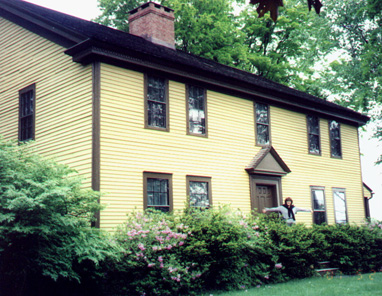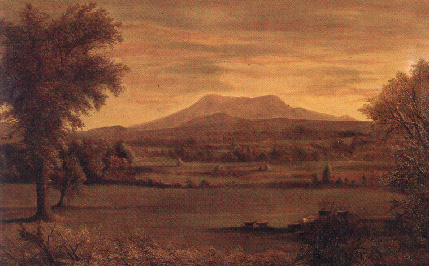 Melville's
house, Pittsfield, Mass.
Melville's
house, Pittsfield, Mass. Herman Melville wrote Moby Dick, among other novels in the 19th Century from this home in the northern Berkshires of western Massachusetts.
 Melville's
house, Pittsfield, Mass.
Melville's
house, Pittsfield, Mass.
Herman Melville, an American author and poet, is said to have been partially inspired by what he saw around him; both the people and the places he visited.
 Melville for example is said to have been inspired by this mountain,
called Mount Greylock, in his conception of the white whale in Moby Dick.
Melville for example is said to have been inspired by this mountain,
called Mount Greylock, in his conception of the white whale in Moby Dick.
While the book should not be read literally, as it is not merely the story of a whaling expedition in search of an elusive and mortally fearsome prey, the White Whale is part of America's mythic traditions and has become a symbol of the ultimate consequences of an obsession that is so overwhelming as to destroy those who become so obsessed. Melville, many people say was a neo-platonist, and thus the story of Moby Dick is best interpreted as a Platonic dialogue where images in this world reflect a hidden truth, much as shadows on a cave wall point to something more substantial which the shadow merely reflects.
Moby Dick then, is a wonderful novel with which to compare and contrast reality and realities, idealism and naturalism to uncover how Melville is telling a story with double, or dialectically opposing meanings. His symbols are both obvious, greed, racism, commercialism and materialism are brought to bear on a small ship --the microcosm of the ship of state (a miniature society)-- adrift in an ocean of time and opportunities.
| Reality |
vs. |
Illusions |
|
actuality |
vs. |
realities |
|
matter,
naturalism |
vs. |
|
|
metaphysical |
For more on real & ideal
Science Index | Site Analysis | Population Index | Global Warming Index | Nature Index | Research sites.
Terms | Glossary | Word webs | Basic vocabulary | Advanced Vocabulary | Antonyms | Synonyms
Writing | Interviews | Free Writing